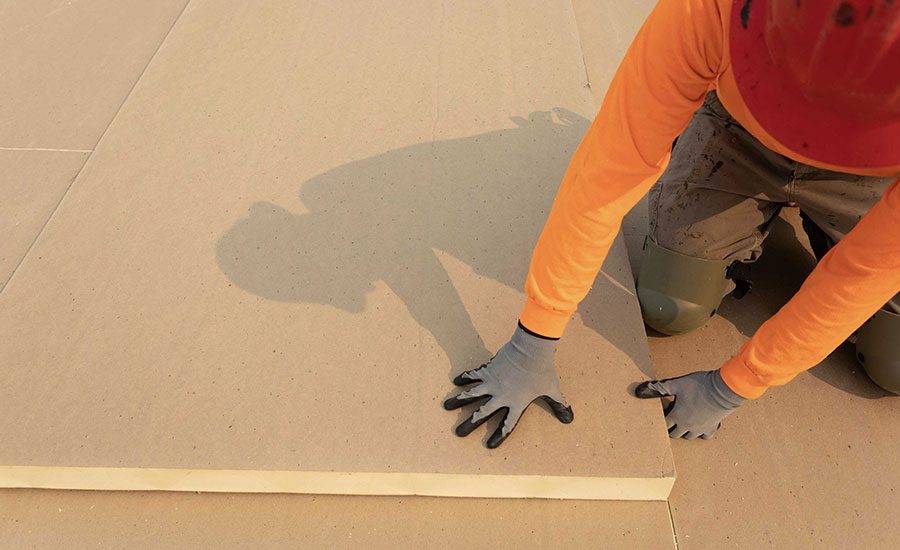
Polyisocyanurate,
or polyiso, roof insulation boards provide a versatile and
energy-efficient solution for low-slope commercial roofing projects.
From new construction to reroof projects on existing buildings,
polyiso’s high R-value allows project teams to meet energy code targets
with less material than alternative products.
Polyiso roof
insulation boards are manufactured with different facer types that
deliver strength, dimensional stability, and unique properties for
various applications. Polyiso high-density roof cover boards and tapered
insulation products complete the portfolio of polyiso roofing products
that deliver performance for any roofing project.
What Are the Available Thicknesses of Polyiso Insulation Boards?
Manufacturers
produce polyiso roof insulation boards in a wide range of thicknesses.
This allows project teams to specify products based on individual
project needs and code requirements. Typical thicknesses for polyiso
insulation range from 1 inch (25.4 mm) to 4.5 inches (114.3 mm).
Regarding
popularity, 2.6-inch (66 mm) thick polyiso roof insulation boards are
often specified. Two layers of 2.6-inch thick polyiso insulation deliver
a total of R-30, equating to the code-required minimum for above-deck
roof insulation for commercial buildings in ASHRAE Climate Zones 4-6 in
the United States.
These climate zones represent a significant
portion of annual construction activity. Thicker products — such as
4-inch thick polyiso boards — may commonly be used as infill panels for
tapered insulation systems.
Multi-layered installation of roof insulation boards can bolster thermal efficiency and mitigate moisture migration.
Image courtesy of PIMA.
How Thick is Too Thick?
Project
teams may ask whether installing thicker polyiso roof insulation boards
should be avoided. The answer is no. Manufacturers provide installation
requirements for polyiso roof insulation, which may include specific
instructions based on the thickness of the insulation boards used.
The
National Roofing Contractors Association (NRCA) had previously
recommended a maximum board thickness of 2.5 inches for polyiso roof
insulation boards. However, the nominal recommendation has been deleted
in the most recent version (2023) of “The NRCA Roofing Manual: Membrane
Roof Systems.” The NRCA manual now directs users to consult the
manufacturer-published installation instructions for recommended
application procedures. See Section 4.9—Polyisocyanurate of the NRCA
manual for additional details.
Why Are Multi-Layered Roof Insulation Systems Important?
Rigid
insulation boards such as polyiso insulation should be installed in
multiple layers, with the joints of each layer staggered. The
multi-layered installation of roof insulation boards is an industry best
practice rooted in building science fundamentals and is required by
modern energy codes.
The benefits include:
-
Reduced thermal losses at insulation joints
-
Reduced thermal bridging from fasteners (when adhering to the top insulation layer)
-
Reduced air leakage
-
Reduced moisture migration in the roof system to the underside of the roof membrane (which can lead to possible condensation)
-
Reduced potential for membrane buckling, ridging, and splitting
The
NRCA manual also suggests that multi-layered roof insulation systems
can increase the dimensional stability of the overall insulation system.
Additionally, project teams should include a roof cover board as part
of any system. Roof cover boards provide a suitable substrate for
membrane attachment and enhance the durability of the roof system. This
is especially important for roofs subject to extreme weather events
(e.g., hail, high winds), consistent service traffic, or roof areas with
renewable energy systems such as rooftop solar. Polyiso high-density
roof cover boards are lightweight, easy-to-handle options that also
deliver added insulation performance (R-2.5 for 0.5-inch [12.7 mm] thick
products).
Additional Information
Project
teams should always consult the manufacturer-published installation
instructions for polyiso products. The Polyisocyanurate Insulation
Manufacturers Association (PIMA) maintains a library of technical
bulletins to support using polyiso roof insulation.
The following
technical bulletins provide additional information on the topics
discussed in this article: “PIMA Technical Bulletin No. 113 — Benefits
of Multiple Polyiso Roof Insulation Layers with Staggered Joints” and
“PIMA Technical Bulletin No. 118 — Recommended Polyiso Insulation
Thicknesses for Meeting Commercial Roof Prescriptive R-value
Requirements.”
For these resources and more information on polyiso insulation, visit polyiso.org.

